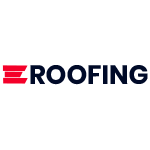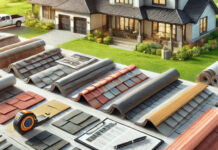If you’re capping off a roof, you have options. The big debate? Dry ridge versus mortar ridge. They may look similar from the ground, but these two methods are worlds apart in terms of installation, durability, and maintenance. Choosing the right one can mean the difference between a roof that’s a fortress against the elements or one that needs constant patch-ups.
So, if you’re deciding how to finish off your ridge tiles, read on to find out whether dry or mortar ridge is the best fit for your home. And if you’re looking to upgrade your ridge tiles, don’t forget to browse our pitched roofing options for top-quality materials!
What is a Mortar Ridge System?
Mortar ridges are the solid, cement-based heroes that hold ridge tiles firmly in place along your roof’s peak. This method involves securing tiles with a cement mixture that provides a unified, classic finish.
With a well-applied mortar ridge, your roof is shielded against wind and rain. You get a watertight barrier. But, as charming as it looks, a mortar ridge does come with its quirks. The cement can crack or wear down over time, especially under the relentless British weather.
Fancy a mortar ridge but need a bit of extra gear? Pop over to our lead flashing section to keep those edges snug and secure.
Pros of Mortar Ridge
Mortar ridge systems have a certain old-school charm—they’re the solid, dependable choice that’s been sealing roofs for centuries. When done right, a mortar ridge offers a seamless, almost sculpted look that sits neatly along the roofline.
The weight of the cement adds stability. It gives your roof that strong, weather-resistant edge. And don’t forget, a well-maintained mortar ridge can last a good long while, keeping the wind and rain at bay for decades.
Plus, it’s a classic look, excellent if you want your home to radiate that ageless, traditional feel.
If you’re after a classic roof that looks like it could outlast the British weather, mortar might just be your match.
Cons of Mortar Ridge
Unfortunately, though, everything has its Achilles heel. For the trusty mortar ridge, that heel is maintenance.
Mortar has a tendency to crack, especially with the UK’s constant shifts between sun, rain, and frost.
Once cracks start, water can sneak in. That means loosening tiles and a roof that could use more patch-ups than an old pair of wellies. So, regular check-ups and repairs are a must to keep it in tip-top shape.
And if you live somewhere the wind likes to make itself known, a mortar ridge may not be the best choice.
Looking to avoid the endless maintenance mayhem? A dry ridge system might just be calling your name. And for those unescapable rainy days, be sure to check out our assortment of guttering solutions to keep that water flowing away from your roof.
What is a Dry Ridge System?
Unlike the cement-heavy approach of mortar, a dry ridge system uses a mechanical fixing to keep ridge tiles securely in place. This involves clips, screws, and a flexible roll that runs along the ridge. This allows air to circulate underneath—ideal for ventilation and keeping moisture out.
Dry ridges are fitted without any messy cement, so installation is quicker and cleaner. It’s a no-fuss, fit-and-forget system – modern, neat, and all set to stand up tall to everything the weather throws its way. And there’s no need for regular maintenance. If you like the idea of a simpler, breezier option, the dry ridge might be just the ticket.
Pros of Dry Ridge
The dry ridge system comes with all the mod cons. It’s designed to flex and bend with the natural movements of your roof, which is a bit of a godsend when you consider the wear and tear of British weather.
It cuts down the chance of cracking (take that, frost!). Also, though, it improves ventilation, which can help stop moisture build-up in your roof space. No cement means no mess, and no ongoing repairs—the dry ridge practically looks after itself.
Even better, it’s swift to install, so you’ll have less time up the ladder and more time admiring the view.
Interested in giving it a go? Make sure you’re equipped with everything you need—take a look at our roof vents to complement that fresh-air flow.
Cons of Dry Ridge
While dry ridge systems might be the low-maintenance counterparts in the roofing family, they do have a few peculiarities.
First off, the initial cost can make your wallet a bit lighter—modern innovation doesn’t always come cheap! Have an eye for the classics? The sleek, almost industrial look of a dry ridge might not charm your socks off like the traditional, hand-finished appearance of mortar.
Some folks just love old school. Before you commit, think about whether the contemporary style of a dry ridge complements your home’s character.
Need more traditional materials? Our lead flashing might be just what your period property needs.
Installation and Cost Differences
When it’s time to choose between dry ridge and mortar ridge, your decision might boil down to two things: how much hassle you can handle, and how deep your pockets are.
Installing a mortar ridge is a bit of an art form, requiring skilled hands and plenty of time—which means it’s often more expensive in terms of labour.
Dry ridge, on the other hand, is pretty much a DIY dream. It’s quicker, involves less faff, and once it’s up, it’s up—no return visits from your friendly local roofer required.
In terms of materials, though, dry ridge systems can be pricier upfront. But bear in mind, they’re a one-and-done deal, so you might save in the long run by avoiding repair costs.
Pondering a DIY installation? Don’t skimp on safety—check out our ladders to make sure you’re as secure as your new ridge.
Picking the Right One for Your Home
Working out what you want – a dry ridge or mortar ridge – isn’t necessarily about tossing a coin. You need to think about what your roof really needs. Consider your local weather (yes, the usual British mix of sun, rain, and surprise snow). Also, how old is your house? And how much fuss are you willing to put up with?
If you love authentic, heritage and don’t mind a bit of upkeep, a mortar ridge might be the choice.
On the flip side, if you prefer a set-it-and-forget-it solution, a dry ridge could be the way to go.
Final Thoughts
And that’s the lowdown on dry vs. mortar ridges. Whether you fancy the traditional appeal of mortar or plump for the sleek efficiency of a dry ridge, your choice will define your roof’s character and functionality for years to come.
Need a bit of assistance? Have some burning questions? Give us a shout – we’d love to help you nail that impeccable roof finish.





